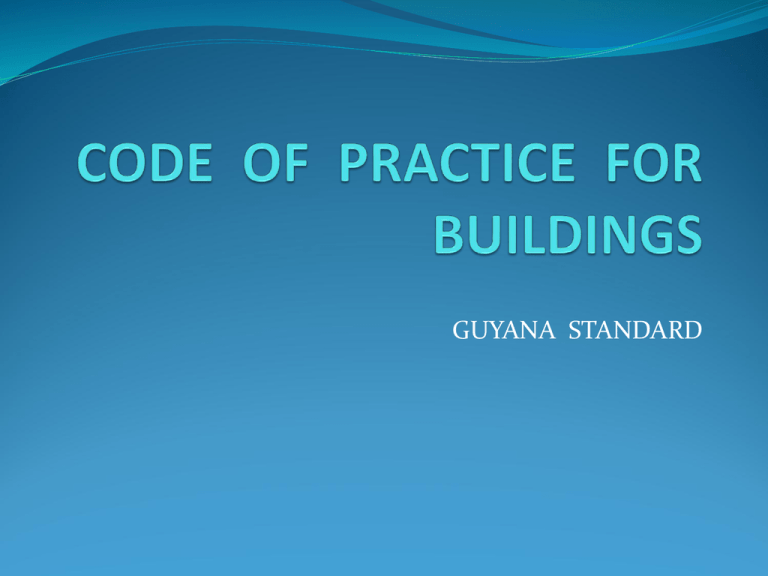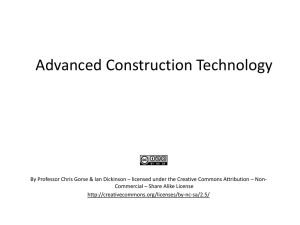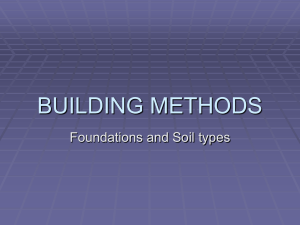Foundation Excavations
advertisement

GUYANA STANDARD Part 13 - Foundations and Excavations Scope Building Classification Site Investigations Excavations Foundations - shallow - deep SCOPE This code specifies guidelines for excavations and foundations for building construction which includes temporary and permanent excavation for foundation, drainage system and utilities. This code applies for low and medium rise buildings. Building Classification Buildings can be classified according to: - Use and occupancy building height (in terms of No. of stories) Based on use and occupancy, buildings can be categorized as: - Residential: Buildings used for domestic purposes, including private and public housing - Non Residential: Buildings for non domestic purposes, such as industrial, commercial or institutional buildings Site Investigations Site investigations shall be conducted for all excavations and foundations works, as specified in Table 1 below. Level 1 2 Description Investigation Details Remarks Preliminary investigation Test pits, undisturbed sampling, field and laboratory testing for soil identification and classification Indicative soil characteristics only required Detailed investigation Boreholes, disturbed and undisturbed sampling, field and laboratory tests Detailed soil report required. Site Investigations cont’d For the various categories of buildings the following investigation shall apply: Low Rise Residential Buildings (Class 1) - May require only Level 1 investigation for the purposes of excavation and foundation works. Medium and high rise residential buildings (classes 2 3) May require both levels 1 and 2 for excavation and foundation works Non Residential buildings (Classes 1-3) Shall require both Levels 1 and 2 investigation. Foundations Design Requirements Foundation designs for residential buildings shall be certified by a qualified engineer before approval is granted. In the design of building foundations, one of the following methods should be applied: Calculation methods for foundations should be based on the latest edition of BS 8007 and Eurocode 7 Prescriptive methods - based on tables of allowable bearing pressures Foundations Minimum Depth Requirements for placement of foundations are: (a) Minimum depth below ground surface for bottom of foundation is 300 mm (b) Building foundations shall not be placed on the topsoil. Materials Shallow foundations and pile caps for deep foundation shall be constructed of concrete. Materials shall be of acceptable quality and shall meet the minimum strength requirements Foundations Materials - cont’d Concrete - The concrete grade for footings shall be 25 N/mm2 or higher and shall be kept moist for at least 7 days for curing and the development of design strength Reinforcement - The steel for primary reinforcement shall be high yield bars with a strength of 410 N/mm2 with a minimum size of 12 mm, and 10 mm for secondary reinforcement. The minimum cover to reinforcement shall be 50 mm Shallow Foundations Minimum Thickness The minimum thickness of a shallow building foundation shall be 250 mm The prescriptive pressures for Foundations in Sands and Clays for a minimum depth of 0.6 m below ground level is given in Tables 6 and 7 respectively in the Code. Settlement The recommended design limits for settlement in clay for raft foundations should be 65 – 100 mm, and 50 mm for raft foundations on sand. Shallow Foundations Settlements - cont’d Table 8 in the Code specifies the Tolerable difference settlements, for different categories of buildings of both concrete and steel, and with the types of damage most likely to occur. Deep Foundations Timber pile foundations shall be provided where the upper soil strata is of poor strength and poor compressibility characteristics. The minimum recommended dimensions for timber piles shall be: (i) minimum butt diameter - 300 mm (ii) minimum tip diameter - 200 mm (iii) limiting structural defects such as reverse bends, twisted grain etc.










